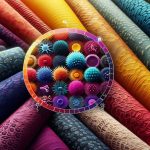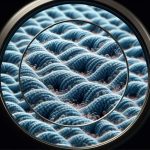You might not think much about the fabrics you wear daily, but those with antimicrobial properties could be a game-changer for your health and hygiene. By incorporating elements like silver or copper, these textiles actively combat bacteria and fungi, reducing odors and minimizing the risk of infections. Imagine the convenience of clothing that stays fresher longer and requires fewer washes. But how exactly do these fabrics work, and what makes them so effective? Understanding the science and benefits behind antimicrobial textiles will open up a world of possibilities you might not have considered before.
Table of Contents
Key Takeaways
- Silver-infused fabrics inhibit bacterial growth and improve hygiene.
- Copper-infused textiles disrupt microbial cell walls, enhancing durability and reducing odors.
- Bamboo fabric is naturally antimicrobial and environmentally friendly.
- Zinc oxide-treated fabrics provide lasting microbial protection and UV resistance.
- Antimicrobial fabrics reduce infections, odors, and washing frequency, contributing to sustainability.
How Antimicrobial Fabrics Work
Antimicrobial textiles operate by incorporating agents that inhibit the growth of bacteria, fungi, and other harmful microorganisms. These agents, embedded into the fabric during manufacturing, create a hostile environment for microbes, preventing them from multiplying. This process is essential for addressing microbial resistance, ensuring that harmful pathogens don't develop immunity over time. By halting microbial growth, these fabrics maintain their integrity and effectiveness, thereby enhancing fabric longevity.
You'll appreciate that one of the most immediate benefits of using antimicrobial fabrics is odor control. When bacteria and fungi can't thrive, they can't produce the unpleasant smells often associated with active wear, socks, and other frequently-used textiles. This not only keeps your garments fresher for longer but also saves you from frequent washing, which can degrade the fabric.
Furthermore, the health benefits of antimicrobial fabrics are notable. By reducing the presence of harmful microorganisms, these fabrics can minimize skin infections and other health issues. Especially in settings like hospitals or gyms, where bacteria and fungi abound, antimicrobial fabrics provide an extra layer of protection, contributing to overall well-being.
Mastering the use of these advanced textiles offers you both practical and health-related advantages.
Types of Antimicrobial Agents
Frequently, you'll find that different antimicrobial agents are used to imbue fabrics with their protective properties, each offering unique benefits and mechanisms of action.
Understanding the distinctions between natural vs synthetic antimicrobial agents is essential. Natural agents, such as silver and copper ions, are renowned for their long-standing efficacy and eco-friendliness. These metals disrupt microbial cell walls, rendering them inactive.
On the other hand, synthetic antimicrobial agents, including quaternary ammonium compounds and triclosan, are engineered to target specific microorganisms, providing tailored solutions.
When evaluating antimicrobial fabrics, consider their cost effectiveness. Natural agents might initially seem more expensive due to the cost of materials like silver. However, they often offer superior durability and a reduced need for frequent reapplication, making them cost-effective in the long run.
Synthetic agents tend to be more affordable up-front but might require more frequent treatments to maintain efficacy.
Mastering the choice between natural vs synthetic antimicrobial agents involves evaluating your specific needs and budget. By doing so, you can select the most appropriate and cost-effective solution, ensuring your antimicrobial fabrics deliver peak performance and longevity.
Understanding these distinctions will empower you to make informed decisions in antimicrobial fabric applications.
Benefits of Antimicrobial Fabrics
You'll enjoy several key advantages when you choose fabrics with antimicrobial properties. First and foremost, they offer significant health benefits. By inhibiting the growth of bacteria, fungi, and other microorganisms, these fabrics can help reduce the risk of infections and allergies. This makes them an excellent choice for anyone looking to maintain a healthier lifestyle.
Another noteworthy advantage is odor control. Antimicrobial fabrics actively combat the bacteria that cause unpleasant odors, ensuring your clothing and textiles stay fresher for longer periods. This feature is particularly beneficial for active individuals who frequently engage in physical activities.
Durability is another area where antimicrobial fabrics excel. These materials tend to last longer because they resist microbial degradation, which can weaken fibers over time. This not only extends the life of your garments but also contributes to sustainability by reducing the need for frequent replacements.
Lastly, antimicrobial fabrics support sustainability. By keeping textiles fresher and more durable, you minimize waste and lower your environmental footprint.
| Feature | Benefit | Impact |
|---|---|---|
| Health Benefits | Reduced risk of infections | Improved well-being |
| Odor Control | Fresher textiles | Enhanced comfort |
| Durability | Longer-lasting fabrics | Cost-effective |
| Sustainability | Less waste | Eco-friendly |
Common Applications
In various industries, fabrics with antimicrobial properties find widespread use due to their health and hygiene benefits. You'll often see these advanced textiles in healthcare settings, where medical scrubs are essential. The antimicrobial qualities reduce the risk of infections, providing both patients and healthcare professionals with an added layer of protection.
In sports, athletic wear made from antimicrobial fabrics guarantees that your gear remains fresh, even after intense workouts. These textiles combat odor-causing bacteria, enhancing your comfort and confidence during physical activities.
At home, antimicrobial bedding offers significant advantages. Your sheets and pillowcases stay cleaner for longer, contributing to a healthier sleeping environment.
For those who prioritize a germ-free home, upholstery fabrics with antimicrobial properties are a wise choice. These materials help maintain cleaner furniture, reducing the spread of bacteria in communal areas.
Popular Antimicrobial Fabrics
Among the popular antimicrobial fabrics, silver-infused textiles stand out for their exceptional ability to inhibit bacterial growth. When you opt for silver-infused fabric choices, you're not just selecting material; you're investing in health benefits that can greatly improve your well-being. Silver ions disrupt bacterial cell function, making these fabrics a stellar choice for anyone aiming to minimize microbial contamination.
Copper-infused fabrics also merit your attention. Known for their broad-spectrum antimicrobial properties, copper disrupts the cell walls of bacteria and fungi. This makes copper-infused textiles ideal for environments where hygiene is paramount, such as hospitals and athletic wear. You're not just choosing fabric; you're choosing a healthier lifestyle.
Bamboo fabric, naturally antimicrobial, offers another excellent option. It's eco-friendly and resists bacteria without the need for chemical additives. By selecting bamboo, you're making fabric choices that benefit both your health and the planet.
Lastly, consider fabrics treated with zinc oxide. These textiles provide lasting protection against a range of microbes, enhancing your health benefits. Zinc oxide is particularly effective in UV protection, making it a dual-purpose choice for outdoor activities.
Comparing Antimicrobial Technologies
Now, let's compare two leading antimicrobial technologies: silver ion technology and copper-infused fabrics.
You'll see how each method combats bacteria and what makes them effective.
This comparison will help you understand which option might be best for your needs.
Silver Ion Technology
When comparing antimicrobial technologies, silver ion technology stands out due to its proven effectiveness and versatility. Silver ion benefits are substantial; this technology offers robust antimicrobial properties that inhibit the growth of bacteria, fungi, and viruses.
By integrating silver ions into fabrics, manufacturers create textiles that aren't only resistant to microbial contamination but also long-lasting in their protective capabilities.
Fabric innovation has reached new heights with silver technology, making it an ideal choice for various applications. Whether you're looking to enhance the hygiene of medical textiles, athletic wear, or everyday clothing, silver ion technology delivers unmatched antimicrobial performance.
The ions disrupt microbial cells by binding to their DNA, effectively neutralizing them and preventing reproduction. This guarantees that your fabrics remain fresh, odor-free, and safe for extended use.
Furthermore, silver ion technology is versatile, easily incorporated into different types of fibers without compromising the fabric's texture or comfort. This makes it a go-to solution for anyone aiming to master the art of creating high-performance, antimicrobial textiles.
Copper-Infused Fabrics
Like silver ion technology, copper-infused fabrics also offer impressive antimicrobial properties, making them another compelling option for high-performance textiles. Copper benefits extend beyond simply killing bacteria; they also enhance the durability of the fabric, making your garments last longer and perform better.
This innovation brings a wealth of health benefits, as copper-infused fabrics can notably reduce the risk of infections and odors.
Consider these compelling reasons to opt for copper-infused fabrics:
- Durability: Copper-infused fabrics are known for their longevity. The antimicrobial properties of copper don't wash out, ensuring the fabric maintains its effectiveness over time.
- Health benefits: Copper has natural antimicrobial properties that can eliminate up to 99.9% of bacteria, viruses, and fungi. This can lead to fewer infections and a healthier living environment.
- Innovation: Integrating copper into fabrics represents a noteworthy leap in textile technology, combining traditional fabric-making techniques with modern scientific advancements.
- Sustainability: Copper-infused fabrics often require less frequent washing, reducing water and energy consumption.
Care and Maintenance
Proper care and maintenance of antimicrobial fabrics guarantee they remain effective and last longer. You'll want to adopt specific cleaning techniques and storage tips to preserve the fabric's integrity. Always read the label; some antimicrobial fabrics require gentle washing with cold water and mild detergent. Avoid bleach and fabric softeners, as they can degrade the antimicrobial properties. Air drying is often recommended, as high heat from dryers may reduce the fabric's effectiveness.
Storing your antimicrobial fabrics properly is just as vital. Keep them in a cool, dry place away from direct sunlight, which can compromise the fabric's longevity. Fold them neatly to avoid creases that could weaken the material over time.
Here's a quick reference table to guide you:
| Action | Do's | Don'ts |
|---|---|---|
| Washing | Use cold water, mild detergent | Avoid bleach, fabric softeners |
| Drying | Air dry or low heat | High heat in dryers |
| Storing | Cool, dry place, away from sunlight | Hot, humid areas, direct light |
Environmental Impact
When you choose fabrics with antimicrobial properties, you're not just looking out for your health, but also the environment.
These fabrics often require fewer washes, reducing textile waste.
Additionally, many are produced using eco-friendly methods, helping to lessen environmental impact.
Reduced Textile Waste
Antimicrobial fabrics can reduce textile waste by extending the lifespan of clothing and other materials. When you use these fabrics, you're embracing sustainable practices that contribute to a healthier planet. By preventing the growth of harmful microbes, these textiles remain fresh and durable for longer periods, thereby reducing the frequency of replacements and minimizing waste.
Consider the benefits:
- Longevity: Antimicrobial properties keep your textiles in use longer, reducing the need for frequent disposal.
- Textile recycling: Less waste means more materials can be efficiently recycled, fostering a more sustainable industry.
- Circular economy: By extending textile lifespans, antimicrobial fabrics support a circular economy where resources are reused and repurposed.
- Upcycling initiatives: Durable fabrics are ideal for upcycling projects, allowing you to create new items from old materials.
With textiles lasting longer, you'll be part of a movement that prioritizes environmental responsibility. You'll find that investing in antimicrobial fabrics isn't just about durability; it's about contributing to a system that values resource efficiency and waste reduction. This approach aligns seamlessly with contemporary goals for a more sustainable and circular textile industry.
Eco-friendly Production Methods
Eco-friendly production methods guarantee that antimicrobial fabrics have a minimal environmental impact right from the manufacturing stage. By adopting sustainable practices, you ensure that every step in the production process is optimized to reduce waste and energy consumption.
For instance, water-efficient dyeing techniques and closed-loop systems substantially cut down on water usage and prevent harmful chemicals from polluting ecosystems.
You can also explore innovative techniques such as using natural antimicrobial agents derived from plants or minerals. These alternatives not only maintain the fabric's efficacy but also reduce reliance on synthetic chemicals that can be harmful to the environment.
Additionally, advancements in biotechnology allow for the development of biodegradable fibers that break down naturally without leaving toxic residues.
Future Trends
Advancements in fabric technology promise exciting future trends in antimicrobial properties, offering enhanced protection and comfort. As sustainable innovations continue to evolve, you'll see fabrics that not only fight bacteria but also align with eco-friendly fashion trends. These fabrics are set to revolutionize the industry by offering benefits that go beyond aesthetics.
The future of antimicrobial fabrics looks incredibly promising, driven by several key factors:
- Sustainable Innovations: New materials and processes will guarantee that antimicrobial fabrics are both effective and environmentally responsible.
- Fashion Trends: Designers will incorporate these advanced fabrics into mainstream and high-end fashion, making them widely accessible.
- Health Benefits: Enhanced antimicrobial properties will provide increased health benefits, reducing the risk of infections and promoting overall well-being.
- Consumer Demand: As awareness grows, consumer demand for antimicrobial fabrics will soar, pushing brands to innovate and improve.
Frequently Asked Questions
How Long Do Antimicrobial Properties Last in Everyday Use?
The effectiveness of antimicrobial properties can last indefinitely, depending on washing frequency and durability. However, antimicrobial resistance can reduce their effectiveness over time. Proper maintenance guarantees they remain functional, offering you the mastery you seek.
Are Antimicrobial Fabrics Safe for Sensitive Skin?
You're wondering if antimicrobial fabrics are safe for sensitive skin. Skin reactions and allergies can happen, so follow dermatologist recommendations. Always test alternatives and monitor for issues. Consult a dermatologist for tailored advice to guarantee safety.
Can Antimicrobial Fabrics Prevent All Types of Infections?
You might think antimicrobial fabrics guarantee infection prevention, but they can't prevent all types of infections. While fabric efficacy is high, antimicrobial resistance can develop, diminishing effectiveness over time. Always consider additional measures for thorough protection.
Do Antimicrobial Treatments Affect Fabric Breathability?
Well, hold the phone! Antimicrobial treatments can indeed affect fabric breathability. However, the right treatments enhance moisture-wicking and odor control without sacrificing comfort or durability, ensuring you stay fresh and comfy all day long.
Are There Any Known Side Effects of Wearing Antimicrobial Clothing?
When wearing antimicrobial clothing, you might experience skin irritation or allergies. These reactions are rare but can occur, especially if you have sensitive skin. Always monitor for any adverse effects and consult a dermatologist if needed.
- Tetron Fabric for Marine Applications: Durability and Use Cases - June 18, 2025
- Tetron Fabric for Outdoor Furniture: Weather Resistance and Care - June 18, 2025
- Tetron Fabric for Wall Coverings: Style and Application Tips - June 18, 2025







